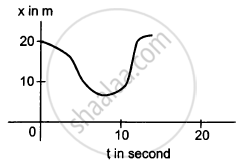Advertisements
Advertisements
Question
A vehicle travels half the distance L with speed V1 and the other half with speed V2, then its average speed is ______.
Options
`(V_1 + V_2)/2`
`(2V_1 + V_2)/(V_1 + V_2)`
`(2V_1 V_2)/(V_1 + V_2)`
`(L(V_1 + V_2))/(V_1V_2)`
Solution
A vehicle travels half the distance L with speed V1 and the other half with speed V2, then its average speed is `underline((2V_1 V_2)/(V_1 + V_2))`.
Explanation:
Consider the diagram below in which motion is as shown below.
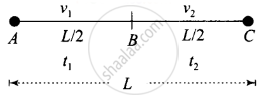
Let the vehicle travels from A to B. Distances, velocities and time have taken are shown. To calculate average speed we will calculate the total distance covered and will divide it by the time interval in which it covers that total distance.
Time taken to travel first half distance `t_1 = (L/2)/v_1 = L/(2v_1)`
Time taken to travel second half distance `t_2 = L/(2v_2)`
Total time = t1 + t2
= `L/(2v_1) + L/(2v_2)`
= `L/2 [1/v_1 + 1/v_2]`
We know that
vav = Average speed
= Total distance/Total time
`v_(av) = L/(L/2[1/v_1 + 1/v_2])`
= `(2v_1v_2)/(v_1 + v_2)`
Important point: Students usually thought that `v_(av) = (v_1 + v_2)/2` but it is not the average speed when two equal distances are covered by speeds v1 and v2.
Remember: If t1 = t2 = t, then `v_(av) = (v_1 + v_2)/2`. Average speed is equal to the arithmetical mean of individual speeds. (if the particle moves in equal intervals of time at different speeds v1 and v2).
And also we should not confuse distance and displacement. Distance ≥ Displacement.
APPEARS IN
RELATED QUESTIONS
The following figure gives the x-t plot of a particle in one-dimensional motion. Three different equal intervals of time are shown. In which interval is the average speed greatest, and in which is it the least? Give the sign of average velocity for each interval.
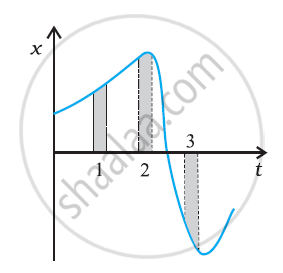
A car travels at a speed of 60 km/hr due north and the other at a speed of 60 km/hr due east. Are the velocities equal? If no, which one is greater? If you find any of the questions irrelevant, explain.
A motor car is going due north at a speed of 50 km/h. It makes a 90° left turn without changing the speed. The change in the velocity of the car is about ______.
Consider the motion of the tip of the minute hand of a clock. In one hour
(a) the displacement is zero
(b) the distance covered is zero
(c) the average speed is zero
(d) the average velocity is zero
Mark the correct statements:
In figure shows the position of a particle moving on the X-axis as a function of time.

When a person leaves his home for sightseeing by his car, the meter reads 12352 km. When he returns home after two hours the reading is 12416 km. What is the average speed of the care during this period?
In the following figure shows the graph of the x-coordinate of a particle going along the X-axis as a function of time. Find the average velocity during 0 to 10 s,
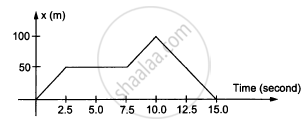
From the velocity-time plot shown in the following figure, find the distance travelled by the particle during the first 40 seconds. Also find the average velocity during this period.
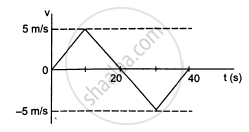
In the following figure shows x-t graph of a particle. Find the time t such that the average velocity of the particle during the period 0 to t is zero.
